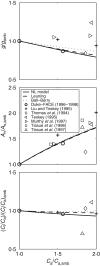A stomatal optimization theory to describe the effects of atmospheric CO2 on leaf photosynthesis and transpiration
- PMID: 19995810
- PMCID: PMC2826246
- DOI: 10.1093/aob/mcp292
A stomatal optimization theory to describe the effects of atmospheric CO2 on leaf photosynthesis and transpiration
Abstract
Background and aims: Global climate models predict decreases in leaf stomatal conductance and transpiration due to increases in atmospheric CO2. The consequences of these reductions are increases in soil moisture availability and continental scale run-off at decadal time-scales. Thus, a theory explaining the differential sensitivity of stomata to changing atmospheric CO2 and other environmental conditions must be identified. Here, these responses are investigated using optimality theory applied to stomatal conductance.
Methods: An analytical model for stomatal conductance is proposed based on: (a) Fickian mass transfer of CO2 and H2O through stomata; (b) a biochemical photosynthesis model that relates intercellular CO2 to net photosynthesis; and (c) a stomatal model based on optimization for maximizing carbon gains when water losses represent a cost. Comparisons between the optimization-based model and empirical relationships widely used in climate models were made using an extensive gas exchange dataset collected in a maturing pine (Pinus taeda) forest under ambient and enriched atmospheric CO2. Key Results and Conclusion In this interpretation, it is proposed that an individual leaf optimally and autonomously regulates stomatal opening on short-term (approx. 10-min time-scale) rather than on daily or longer time-scales. The derived equations are analytical with explicit expressions for conductance, photosynthesis and intercellular CO2, thereby making the approach useful for climate models. Using a gas exchange dataset collected in a pine forest, it is shown that (a) the cost of unit water loss lambda (a measure of marginal water-use efficiency) increases with atmospheric CO2; (b) the new formulation correctly predicts the condition under which CO2-enriched atmosphere will cause increasing assimilation and decreasing stomatal conductance.
Figures






Similar articles
-
On the complementary relationship between marginal nitrogen and water-use efficiencies among Pinus taeda leaves grown under ambient and CO2-enriched environments.Ann Bot. 2013 Mar;111(3):467-77. doi: 10.1093/aob/mcs268. Epub 2013 Jan 8. Ann Bot. 2013. PMID: 23299995 Free PMC article.
-
An improved representation of the relationship between photosynthesis and stomatal conductance leads to more stable estimation of conductance parameters and improves the goodness-of-fit across diverse data sets.Glob Chang Biol. 2022 Jun;28(11):3537-3556. doi: 10.1111/gcb.16103. Epub 2022 Feb 18. Glob Chang Biol. 2022. PMID: 35090072
-
Increase in leaf temperature opens stomata and decouples net photosynthesis from stomatal conductance in Pinus taeda and Populus deltoides x nigra.J Exp Bot. 2017 Mar 1;68(7):1757-1767. doi: 10.1093/jxb/erx052. J Exp Bot. 2017. PMID: 28338959 Free PMC article.
-
Gas valves, forests and global change: a commentary on Jarvis (1976) 'The interpretation of the variations in leaf water potential and stomatal conductance found in canopies in the field'.Philos Trans R Soc Lond B Biol Sci. 2015 Apr 19;370(1666):20140311. doi: 10.1098/rstb.2014.0311. Philos Trans R Soc Lond B Biol Sci. 2015. PMID: 25750234 Free PMC article. Review.
-
The functional significance of the stomatal size to density relationship: Interaction with atmospheric [CO2] and role in plant physiological behaviour.Sci Total Environ. 2023 Mar 10;863:160908. doi: 10.1016/j.scitotenv.2022.160908. Epub 2022 Dec 16. Sci Total Environ. 2023. PMID: 36535478 Review.
Cited by
-
The physiological basis for genetic variation in water use efficiency and carbon isotope composition in Arabidopsis thaliana.Photosynth Res. 2014 Feb;119(1-2):119-29. doi: 10.1007/s11120-013-9891-5. Epub 2013 Jul 28. Photosynth Res. 2014. PMID: 23893317 Free PMC article.
-
WRKY1 regulates stomatal movement in drought-stressed Arabidopsis thaliana.Plant Mol Biol. 2016 May;91(1-2):53-65. doi: 10.1007/s11103-016-0441-3. Epub 2016 Jan 28. Plant Mol Biol. 2016. PMID: 26820136
-
When do plant hydraulics matter in terrestrial biosphere modelling?Glob Chang Biol. 2024 Jan;30(1):e17022. doi: 10.1111/gcb.17022. Epub 2023 Nov 14. Glob Chang Biol. 2024. PMID: 37962234 Free PMC article.
-
Does Size Matter? Atmospheric CO2 May Be a Stronger Driver of Stomatal Closing Rate Than Stomatal Size in Taxa That Diversified under Low CO2.Front Plant Sci. 2016 Aug 24;7:1253. doi: 10.3389/fpls.2016.01253. eCollection 2016. Front Plant Sci. 2016. PMID: 27605929 Free PMC article.
-
Diurnal Change of the Photosynthetic Light-Response Curve of Buckbean (Menyanthes trifoliata), an Emergent Aquatic Plant.Plants (Basel). 2022 Jan 10;11(2):174. doi: 10.3390/plants11020174. Plants (Basel). 2022. PMID: 35050061 Free PMC article.
References
-
- Aalto T, Hari P, Vesala T. Comparison of an optimal stomatal regulation model and a biochemical model in explaining CO2 exchange in field conditions. Silva Fennica. 2002;36:615–623.
-
- Ainsworth EA, Rogers A. The response of photosynthesis and stomatal conductance to rising [CO2]: mechanisms and environmental interactions. Plant, Cell & Environment. 2007;30:258–270. - PubMed
-
- Albertson JD, Katul GG, Wiberg P. Relative importance of local and regional controls on coupled water, carbon, and energy fluxes. Advances in Water Resources. 2001;24:1103–1118.
-
- Baldocchi D, Meyers T. On using eco-physiological, micrometeorological and biogeochemical theory to evaluate carbon dioxide, water vapor and trace gas fluxes over vegetation: a perspective. Agricultural and Forest Meteorology. 1998;90:1–25.
-
- Ball JT, Woodrow IE, Berry JA. A model predicting stomatal conductance and its contribution to the control of photosynthesis under different environmental conditions. In: Biggins I, editor. Vol. 4. Dordrecht: Martinus Nijhoff; 1987. pp. 221–224. Progress in photosynthesis research. Proceedings of the VII International Congress on Photosynthesis.

